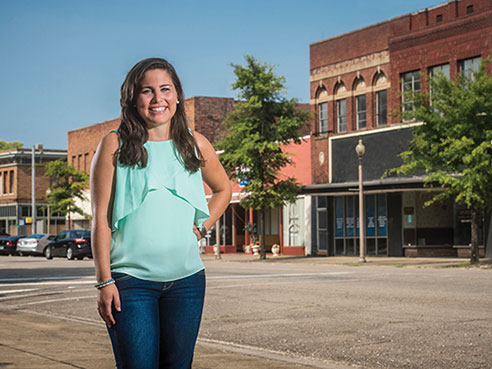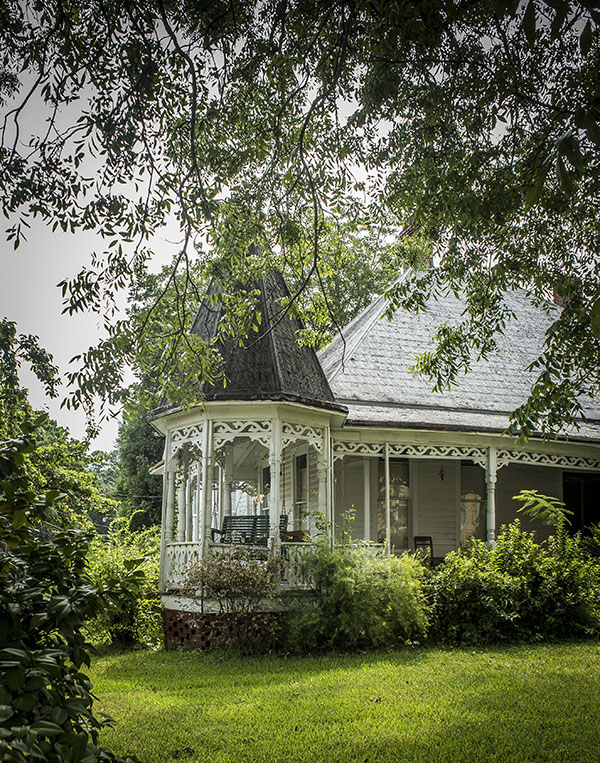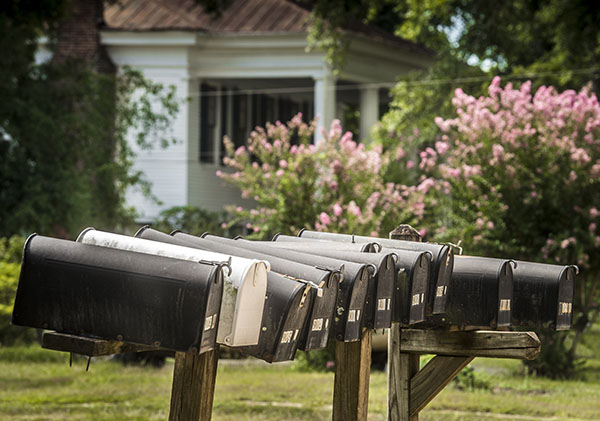 Meghan Pattison, a senior, worked with Better Basics, a literacy organization serving elementary school-age students in the city of Fairfield.Written by Matt Windsor
Meghan Pattison, a senior, worked with Better Basics, a literacy organization serving elementary school-age students in the city of Fairfield.Written by Matt Windsor
Media contact: Tyler Greer
On Main Street in Greensboro, in the shadow of a massive blue water tower alerting visitors that they have reached the Catfish Capital of Alabama, is a compact storefront marked with a large metal horseshoe. This is the Community Clubhouse, headquarters of Project Horseshoe Farm, a grassroots service organization that works to support and inspire vulnerable members of the community, from children to senior adults.
The Clubhouse has become a home away from home for dozens of elderly and mentally disabled residents of Hale County. They gather each morning to play cards, exercise, swap stories, drink coffee, and take cooking classes. A few blocks away, at Greensboro Elementary School, where aging window units trundle along to keep the classrooms cool, Project Horseshoe Farm staff members maintain another sanctuary. In the cafeteria, 60 to 70 students choose to stay three hours after school each afternoon to work on math problems and reading assignments with volunteer mentors.
It’s all a long way from the high-tech UAB Hospital, where students at the UAB School of Nursing learn the state of the art in patient care. And that’s exactly the point. Last fall, instructor Sallie Shipman, Ed.D., R.N., along with instructor Laura Debiasi, D.N.P., M.P.H., BSBME, R.N., NP-C, launched a new required course for seniors called Concepts of Community and Public Health Nursing. “We want to show them that there is a whole other side of nursing outside of a big hospital,” Shipman says. “They’ve learned how to practice individualized care; now we’re giving them the chance to apply that to population and community care.”
Projects with purpose
At the beginning of the semester, the nursing students are matched with one of 30 partner agencies, in locations stretching from North Birmingham to the heart of central Alabama’s Black Belt, depending on their intended practice specialty and the patient population that most interests them. They work with organizations that serve the homeless, Latino immigrants, patients with HIV, disadvantaged youths, and more. The students’ mission is to find new ways to help. Over the course of the semester, they spend at least 40 hours working with their agencies, and dozens more hours developing curricula and other materials as part of a sustainable project they can leave behind.
This spring, Jamie Furman and seven classmates made the 90-minute trip from Birmingham to Greensboro each Tuesday. In the mornings, they worked with the adults in the Community Clubhouse, “helping them with exercises and playing dominoes and other games,” Furman says. In the afternoons, the UAB students visited the elementary school, “helping with math tutoring and working in some teaching moments—general first aid, how to care for someone with a sprain or a burn, and how to do hands-only CPR.”
The health-care tips “may seem like little things, but much of the time these kids are watching their younger siblings after school,” says Lizzie Robbins, youth program director at Project Horseshoe Farm. “Having those skills and the confidence to use them is a huge boost. And just having the nurses come in and talk gives these kids a chance to see that they can be like them — that this is a field they may want to go into one day. It makes it real and attainable.”
“I really liked getting to know the community,” says Furman, who is from Vestavia Hills. “When I worked on the heart-lung transplant unit at UAB, I saw a lot of people who had come to UAB from rural communities. Working in Greensboro made it easier for me to relate to those patients.”
 "We want to show [the students] a whole other side of nursing outside of a big hospital."
"We want to show [the students] a whole other side of nursing outside of a big hospital."
Pain and pleasures
Shipman, who was a public health nurse for 18 years in and around Alabama’s Black Belt, says she hopes that students get a sense of the obstacles patients face in rural areas—and the pleasures of life in the country. Students who travel to Hale County start off with a tour that fills them in on the region’s history and culture. Just down the street from the Community Clubhouse is a home where Martin Luther King Jr. hid out for a night in March 1968, and the surrounding countryside holds several architectural gems designed by the famous Rural Studio. The UAB students also learn about challenges that local residents face, including sparse jobs and transportation options.
“Wherever we go, when the students are here, they go with us,” says Regina Knox, executive director of the West Central Alabama Area Health Education Center (AHEC), which is based in Greensboro. AHEC staff members travel to middle and high schools in a 13-county area, educating students about careers in health care. They also offer continuing education for health-care workers. “Our whole purpose is to encourage students to come back to a rural community and take part in public service, and then to support them once they’re in the workforce,” Knox says.
“That is so beneficial,” says Morgan Edwards, a student in the UAB nursing course who worked with Knox this past spring. Edwards hails from Woodland, Alabama, “a very small town with one clinic and a dentist’s office,” she says. When she was growing up, the only health care workers she knew were doctors, nurses, and dentists, Edwards explains. But AHEC workers “teach the students about many different positions—physician assistants, pharmacy techs, and other jobs—that are available,” she says. “When they know the options, they can pursue a degree and then come back to their community.”
Shaping dreams
Hoping to spark an interest in science among local high schoolers, Edwards and fellow student Nicole DeLuca developed a hands-on course about sickle cell anemia, using Play-Doh to create a visceral model of red blood cells. “The students were very receptive,” Edwards says. “They wanted to know more, and learn about other diseases.”
The UAB course has “been very successful,” Knox says. “The nursing students see the kind of impact they can have even in a short period of time—how they are able to impact someone’s education.”
Edwards, who graduated from UAB in April and now works as a registered nurse in Carrollton, Georgia, is modeling that path. She plans to go back to school after getting two years of work experience. “I want to end up with a nurse practitioner degree and work in a rural clinic close to home,” she says.
“I cried when I read that she wants to be a rural nurse practitioner,” Shipman says. “I tell the students, ‘If I can make just one of you love public health, and every one of you understand something of the realities that your patients face, I’ll be happy,’” she adds. “Do your patients have the money to buy the medicines they have been prescribed? Do they have a way to get to the doctor’s office? Do they even have electricity or running water?”
 "When I worked in the heart-lung transplant unit at UAB, I saw a lot of people who had come from rural communities. Working in Greensboro made it easier for me to relate to those patients." — Jamie FurmanInfectious enthusiasm
"When I worked in the heart-lung transplant unit at UAB, I saw a lot of people who had come from rural communities. Working in Greensboro made it easier for me to relate to those patients." — Jamie FurmanInfectious enthusiasm
Students in the course working with agencies in urban environments find that, even with amenities of a bigger city, many populations have special needs. Meghan Pattison (pictured at top), a senior from Peachtree City, Georgia, worked with Better Basics, a literacy organization serving elementary school-age students in the city of Fairfield (pictured below), just a few miles west of downtown Birmingham.
“We realized that they had a huge deficiency in basic health-care knowledge,” Pattison says. She and her two partners developed a seven-part series of lessons about fitness, nutrition, hygiene, oral health, and more. They emphasized interactive activities— using a product called Glow Germ and a black light to show the kids proper handwashing technique, for example. The last lesson was on fire safety. “Many of the children were afraid of firefighters,” Pattison says. “There have been instances when kids would run away when fire trucks arrived.” So the UAB students arranged a visit from the local fire department. “The firefighters explained everything about their uniforms and how quickly they have to put them on in an emergency,” Pattison says. Then the firefighters gave a demonstration. “The kids loved it,” she says. “We learned that if you make the lessons engaging, the children will be much more likely to remember them.”
Each community will hold on to those lessons as well. “Every project that our UAB students develop stays with each agency” and can be implemented again, Shipman points out. And at the end of the semester, students share these lessons with their peers. “It’s amazing how different the projects are,” Shipman says. “Each student has a different take on community health, and they all learn from each other.”